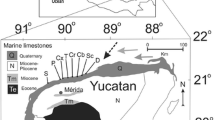Abstract
We have applied the novel analytical method NanoSIMS to cephalopod statoliths for the first time in order to analyse their chemical microstructure, using a spatial resolution of 400 nm. This technique makes it possible to analyse in situ nano-scale chemical variations between increment layers. In statoliths of the boreoatlantic armhook squid Gonatus fabricii, we found distinct concentration patterns indicating a periodicity in strontium and sodium distributions. Sr and Na show a negative relation, both elements showing alternating patterns where the increments vary in width between approximately 1 and 5 μm. Results suggest, that aragonite deposited during the night is rich in Na and poor in Sr, while aragonite deposited during the day is rich in Sr and poor in Na. This study demonstrates the excellent suitability of NanoSIMS for nano-scale microchemical analyses of aragonite, providing new information on calcification processes and individual life histories. Possible future fields of application include not only cephalopod statoliths, but also virtually all biomineralized tissues in aquatic organisms like fish otoliths, gastropod statoliths, bivalve shells, foraminifers and corals.


Similar content being viewed by others
References
Arkhipkin AI (2005) Statoliths as ‘black boxes’ (life recorders) in squid. Mar Freshw Res 56:573–583
Arkhipkin AI, Bjørke H (2000) Statolith shape and microstructure as indicators of ontogenetic shifts in the squid Gonatus fabricii (Oegopsina, Gonatidae) from the Norwegian Sea. Polar Biol 23:1–10
Arkhipkin AI, Campana SE, FitzGerald J, Thorrold SR (2004) Spatial and temporal variation in elemental signatures of statoliths from the Patagonian longfin squid (Loligo gahi). Can J Fish Aquat Sci 61:1212–1224
Bath-Martin G, Thorrold SR, Jones CM (2004) Temperature and salinity effects on strontium incorporation in otoliths of larval spot (Leiostomus xanthurus). Can J Fish Aquat Sci 61:34–42
Bettencourt V, Guerra A (2000) Growth increments and biomineralization process in cephalopod statoliths. J Exp Mar Biol Ecol 248:191–205
Campana SE (1999) Chemistry and composition of fish otoliths: pathways, mechanisms and applications. Mar Ecol Prog Ser 188:263–297
Ferrier-Pages C, Boisson F, Allemand D, Tambutte E (2002) Kinetics of strontium uptake in the scleractinian coral Stylophora pistillata. Mar Ecol Prog Ser 245:93–100
Hillion F, Daigne B, Girard F, Slodzian G (1993) A new high performance instrument: The Cameca Nanosims 50. In: Benninghoven A. et al (eds) Proceedings of the 9th SIMS Conference, John Wiley and Sons, New York, pp 254–257
Ikeda Y, Okazaki J, Sakurai Y, Sakamoto W (2002) Periodic variation in Sr/Ca ratios in statoliths of the Japanese Common Squid Todarodes pacificus Steenstrup, 1880 (Cephalopoda: Ommastrephidae) maintained under constant water temperature. J Exp Mar Biol Ecol 273:161–170
Ikeda Y, Arai N, Kidokoro H, Sakamoto W (2003) Strontium:Calcium ratios in statoliths of Japanese common squid Todarodes pacificus (Cephalopoda: Ommastrephidae) as indicators of migratory behaviour. Mar Ecol Prog Ser 251:169–179
Jackson GD (1994) Application and future potential of statolith increment analysis in squid and sepioids. Can J Fish Aquat Sci 51:2612–2625
Kristensen TK (1980) Periodical growth rings in cephalopod statoliths. Dana 1:39–51
Kristensen TK (1984) Biology of the squid Gonatus fabricii (Lichtenstein, 1818) from West Greenland waters. Meddr Grønland Biosci 13:1–20
Lipinski MR (1993) The deposition of statoliths: a working hypothesis. In: Okutani T, O’Dor RK, Kubodera T (eds) Recent advances in cephalopod fisheries biology. Tokai University Press, Tokyo, pp 241–262
Lipinski MR, Przybylowicz WJ, Durholtz MD, Mesjasz- Przybylowicz J (1997) Quantitative micro-PIXE mapping of squid statoliths. Nucl Instr Meth Phys Res B 130:374–380
Meibom A, Cuif JP, Hillion F, Constantz BR, Juillet-Leclerc A, Dauphin Y, Watanabe T, Dunbar RB (2004) Distribution of magnesium in coral skeleton. Geophys Res Lett 31:L23306, DOI:10.1029/2004GL021313
Morris CC (1991a) Statocyst fluid composition and its effects on calcium carbonate precipitation in the squid Alloteuthis subulata (Lamarck, 1798): towards a model for biomineralization. Bull Mar Sci 49(1–2):379–388
Morris CC (1991b) Methods for in situ experiments on statoliths increment formation, with results for embryos of Alloteuthis subulata. In: Proc Int Workshop held in the Instituto di Tecnologia della Pesca e del Pescatto (ITPP–CNR), Mazara del Vallo, Italy, 9–14 October 1989, Squid Age Determination Using Statoliths, NTR–ITPP Spec. Publ. No. 1, pp 67–72
Radtke RL (1983) Chemical and structural characteristics of statoliths from the short-finned squid Illex illecebrosus. Mar Biol 76:47–54
Ribergaard MH, Buch E (2005) Oceanographic Investigations off West Greenland 2004. NAFO Scientific Council Documents 05/019
Smith SV, Buddermeier RW, Redalje RC, Houck JE (1979) Strontium-Calcium thermometry in coral skeletons. Science 204:404–407
Yatsu A, Mochioka N, Morishita K, Toh H (1998) Strontium/Calcium ratios in statoliths of the neon flying squid Ommastrephes bartrami (Cephalopoda) in the North Pacific Ocean. Mar Biol 131:275–282
Zacherl DC, Paradis G, Lea DW (2003) Barium and strontium uptake into larval protoconchs and statoliths of the marine neogastropod Kelletia kelletii. Geochim Cosmochim Acta 67:4091–4099
Zumholz K, Klügel A, Hansteen TH, Piatkowski U (in press, a) Statolith microchemistry traces environmental history of the boreoatlantic armhook squid Gonatus fabricii. Mar Ecol Progr Ser
Zumholz K, Hansteen TH, Piatkowski U, Croot P (in press, b) Influence of temperature and salinity on the trace element incorporation into statoliths of the common cuttlefish (Sepia officinalis). Mar Biol
Acknowledgements
CAMECA generously provided lab space, facilities, and hospitality during the measurements in Paris. We are grateful to Kai Wieland and the crew of RV “Paamiut” for collecting the cephalopods, and Rikke P. Frandsen for assistance with dissecting specimens. This study was supported by grants from the Deutsche Forschungsgemeinschaft (Pi 203/11-1, Pi 203/11-2 and Ha 2100/9-1).
Author information
Authors and Affiliations
Corresponding author
Rights and permissions
About this article
Cite this article
Zumholz, K., Hansteen, T., Hillion, F. et al. Elemental distribution in cephalopod statoliths: NanoSIMS provides new insights into nano-scale structure. Rev Fish Biol Fisheries 17, 487–491 (2007). https://doi.org/10.1007/s11160-006-9036-4
Published:
Issue Date:
DOI: https://doi.org/10.1007/s11160-006-9036-4




